Introduction
“Venice Beach
extends two and one-half miles from the City of Santa Monica in the north to
the Marina Del Ray channel in the south. A promenade and boardwalk backs the
beach in the northern reach, while the southern reach is backed by residential
development. A mix of residential and commercial infrastructure is hosted
further upland.”[1]
 |
The initial plans for Venice Beach in 1905.
|
The Historical State of Venice Beach
Much of the surrounding environment around Venice Beach consisted of Marsh and coastal wetlands. This marsh ecosystem is a type of wetland that was dominated by grasses, reeds and rushes. Much of the animals found in this ecosystem were birds that fed on various organisms that lived in the lush environment between the aquatic coastline and terrestrial marshland. [12]
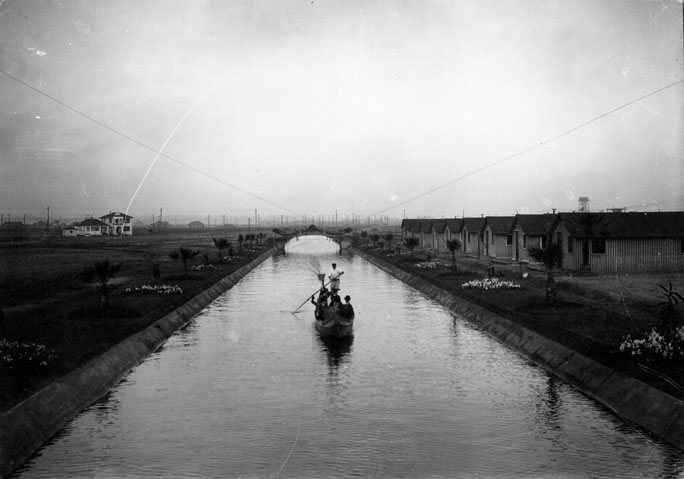 |
| (1905) - A boat glides along a canal in Venice, in 1905. Notice the newly planted palm trees along the sides of the canal, and bungalows are visible at right. http://waterandpower.org/Historical_DWP_Photo_Collection_LA_Public_Library/Canal_1905.jpg |
Due to the vision of Tobacco millionaire Abbot Kinney, the area was developed as a seaside resort. Kinney had dug several miles of canals to drain the marshes for his residential area, built a 1,200-foot (370 m)-long pleasure pier with an auditorium, ship restaurant, and dance hall, constructed a hot salt-water plunge, and built a block-long arcaded business street with Venetian architecture. [9]
.jpg) |
A gondolier on the Venice Canals, 1909.
|
Over time, some of these canals were paved over for development into the current beachfront of Venice Beach. Today, while there are still some remaining canal fronts that emulate a wetlands ecosystem, much of the area has been developed along with the coastline ecosystem, disrupting the environment. [9]
 |
Workers build the canals, 1905.
|
These disruptions caused changes in the wildlife of the area, such as the loss of the threatened California Least Tern. But conservation efforts recently have brought back this threatened migratory bird in the Venice Beach area. [15]
 |
The California Least Tern, an endangered migratory bird.
|
History:
In 1904, Cigarette magnate, Abbot Kinney, bought 160
acres of coastal marshland just south of Santa Monica with the hopes of
developing a “Venice of America” In this project, the Grand Canal (which is a
network of two smaller canals) and a central lagoon was created. The central
lagoon was historically used for hunting and fishing. In order to complete “the
look” gondoliers and gondolas were actually imported from Italy and arched
“Venetian bridges” joining the canals” Later on hotels, such as the St. Mark’s
Hotel, cafes and auditoriums were constructed to attract visitors.
Unfortunately, Venice starting declining after Abbot Kinney’s death in 1920 due
to flaws in the designs of the canals and sewage system. There was severe
negligence of the canals causing dirtiness and stagnation in addition to the
inadequate sewage system. The construction of the sewage system failed to take
into consideration the growing population. Furthermore, the streets of Venice
were made for pedestrians, not automobiles. Lamentably, all four canals in
Venice were shut down and paved over. [16]
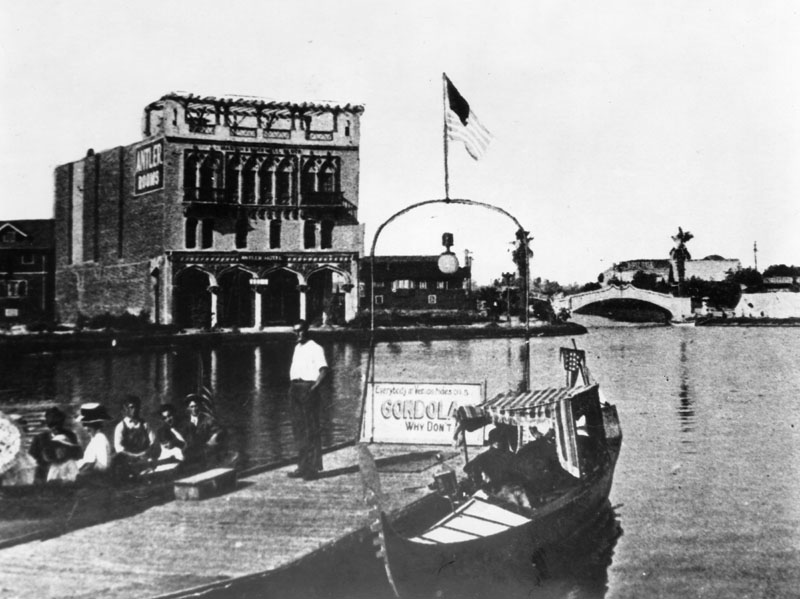 |
| (1905) - View of the Lagoon at Venice. Groups of people pay for a boat or a gondola ride on the canal. http://waterandpower.org/Historical_DWP_Photo_Collection_LA_Public_Library/Venice_Lagoon.jpg |
Venice beach is three miles long, between Marine Street and Spinnaker Street. Venice was one of the first beaches to have full-time professional lifeguard protection. Popular activities include swimming, surfing, and diving. Fishing is huge and some of the fish include rockfish, California Halibut, and seabass. There is a long asphalt walkway paralleling Venice beach from Navy Street to Washington Blvd. It was built just a year later (after the canals were constructed) in 1905 by Abbot Kinney. [16]
Benefits
of Venice Beach
Venice Beach
is a huge source of revenue for the city of Los Angeles with 16 million
visitors annually. [14] The source of revenue comes from hotels on the
beachside, eateries, shops, and other small businesses.
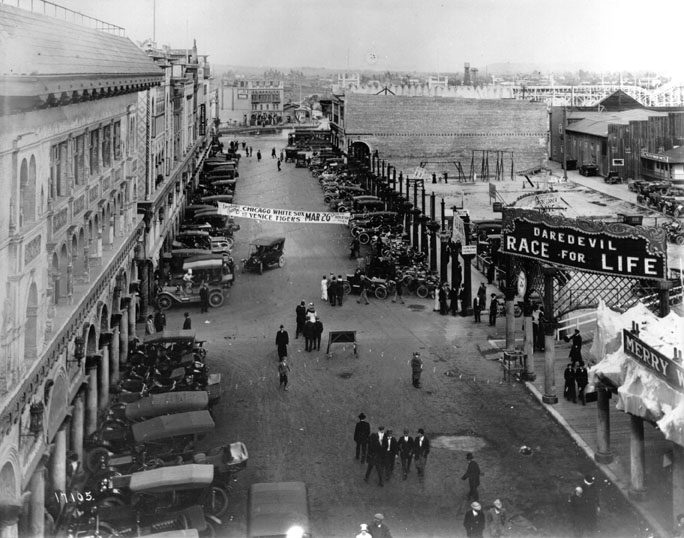 |
(1913) - Looking from a roof at the end of Windward in Venice, one can see the street below and in the distance the piers along the ocean.
|
Another benefit would obviously be human
entertainment. As the number one most visited beach in the U.S., tourists from
all over the world come to enjoy the wild shows performed by Venice locals and
shopping at the various stands for hand-crafted goods. [2]
In a sense,Venice
Beach is a different culture in and of itself where people from different
backgrounds merge together to enjoy a simple, yet magnificent scenery in
addition to whole slew of recreational activities.
 |
Venice Beach and Boardwalk Today
|
Therefore the preservation of Venice Beach ecosystem is a microcosm of how we as a society will leave a better environment for out posterity.
Human Impact on Venice Beach
Venice beach is widely known for tourism and creation, so there are going to be a few consequences from the amount of people visiting. A couple recreational activities include swimming, skating, surfing, fishing, tanning, and dining. With this in mind, trash or litter is left behind a lot of the times. Also, sunscreen and/or suntan oil can wash off and seep into the water or even stick to the sand. [3]
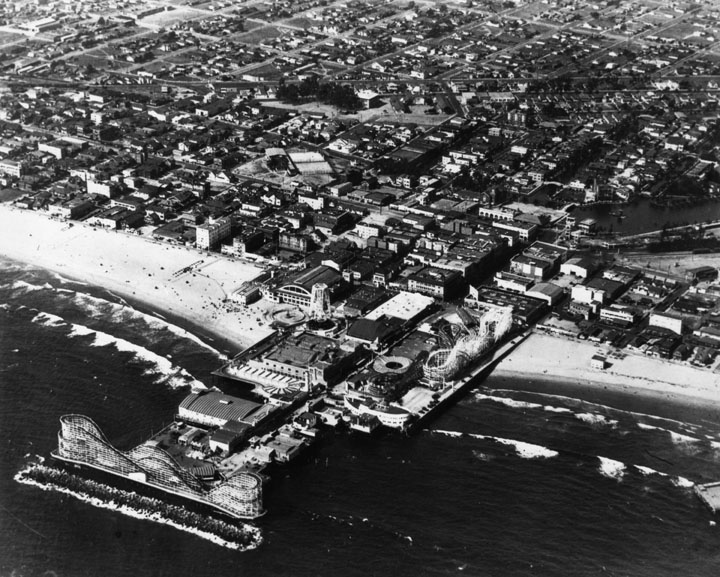 |
(ca. 1925) - Aerial view of Venice, its beach and pier. The canals are visible at the extreme right.
http://waterandpower.org/Historical_DWP_Photo_Collection_LA_Public_Library/Venice_Beach_1925.jpg
|
Three major impacts include erosion rates, pollution
levels, and marine life:
1. Erosion: There has been a lot of construction at
Venice Beach as seen by the rows of apartment complexes and shops/ dining
places which results in less sand. . As recreation increases, there is an accelerated
deterioration of the ecosystem because there is no natural preservation.
 |
The canals of Venice, Los Angeles
|
When there is more building and construction being
done, destruction of vegetation on sand dunes quickly follows. [17] Sand dunes help decrease erosion on the beach and
it is now illegal to walk on or dig through sand dunes because it could be
lethal to plants inside it. There are certain beach plants that grow inside
these sand dunes with their roots reaching 20 feet deep into the sand. The deep
roots support and maintain the plant’s position in the sand so the wind cannot
easily blow it away [7]
Now the plant is able to “catch” the sand which in turn lowers the mobility of
the sand. Since the 1970’s, LA County has built sand dunes to protect a “public
asset.” [18]
Additionally, these dunes can provide
habitats/nesting for the endangered California Least Tern especially with the
vegetation inside the sand dunes. Any sand-leveling activities can greatly put
these endangered species at risk. [22]
 |
| Erosion, Venice Beach, California. http://cdn.coastalcare.org/wp-content/uploads/2013/08/venice-beach-erosion-ca.jpg |
2. Pollution: Even worse is that humans are
contributing by leaving behind trash. About 90% of the debris in the ocean is
plastic and plastic can take up to 10-400 years to decompose [4] Glass is
another type of litter that is left behind on beaches. Instead of 10-400 years
to decompose, glass takes up to 1 million years [5] In addition to plastic and
glass, cigarettes, cups, food wrappers, and bottles add to the growing
negligence left behind by humans. Another type of pollution is from drainage in
sewage pipleines. One too many times, a friend has told me about swimming at
Venice beach only to encounter fecal matter floating beside her. This can lead
to major sickness and illness caused by the bacteria and viruses.
Palm trees along the Venice Boardwalk
|
3. Marine Life: There are thousands of sand surface
organisms and deep living invertebrates (among others) that flourish in the
sands of Venice Beach. Beach maintenance vehicles and mechanical beach sweepers
(used to clean the surface of the sand) can actually destroy the organisms
themselves and wrack. Wrack is the culmination of seaweeds, organisms, and
materials that are left behind after a tide. [6]
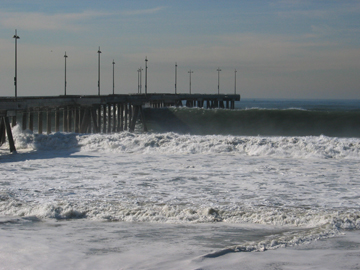 |
Waves at the Pier, December 21, 2005
|
Wrack is crucial
for several organisms because it provides food and shelter. If there is low
food supply and an unstable home, then it will lead to a less diverse
environment. [7] In relation to sport fishing, sometimes there are illegal catches
where too many organisms are caught before they can reproduce or sometimes it
might be a protected species. This can damage marine conservation goals “the
health of a marine ecosystem” causing the biodiversity value to go down. [8]
The Amazing Grunion, a fish popularly hunted for sport across California Beaches.
http://www.dfg.ca.gov/marine/images/grugrfx3.gif
 A group of California Least Tern's |
| http://www.pacificbio.org/initiatives/ESIN/Birds/CaliforniaLeastTern/LeastTern_photo.jpg |
As an endangered species, the California Least Tern (Sternula
antillarum browni), usually resides in sandy beaches along the Southern Coast
of the U.S. Since it is a migratory bird, it is only present at the Venice
Beach Least Tern Colony from April through August, its breeding season. There has been substantial predation pressure
from the American Crow (Corvus brachyrynchos) [19] With the amount of construction and humans introduced into this ecosystem,
conditions have increased “the number of synanthropic generalist predators;
this increase has lead to high rates of predation on local beach-nesting bird
populations” [19] Crows usually prey on the California Least Tern when they are eggs or
fledglings because that’s when they’re most vulnerable. Consequently, this has
a harmful effect on the reproductive success of the Least Tern which is why
they are now endangered. With the huge amount of visitors who come to Venice
beach, it is expected that there will be a huge amount of trash and litter left
behind. This is what attracts crows to Venice Beach and makes it the perfect
foraging grounds because crows will feast on food subsidies in the form of
human refuse.
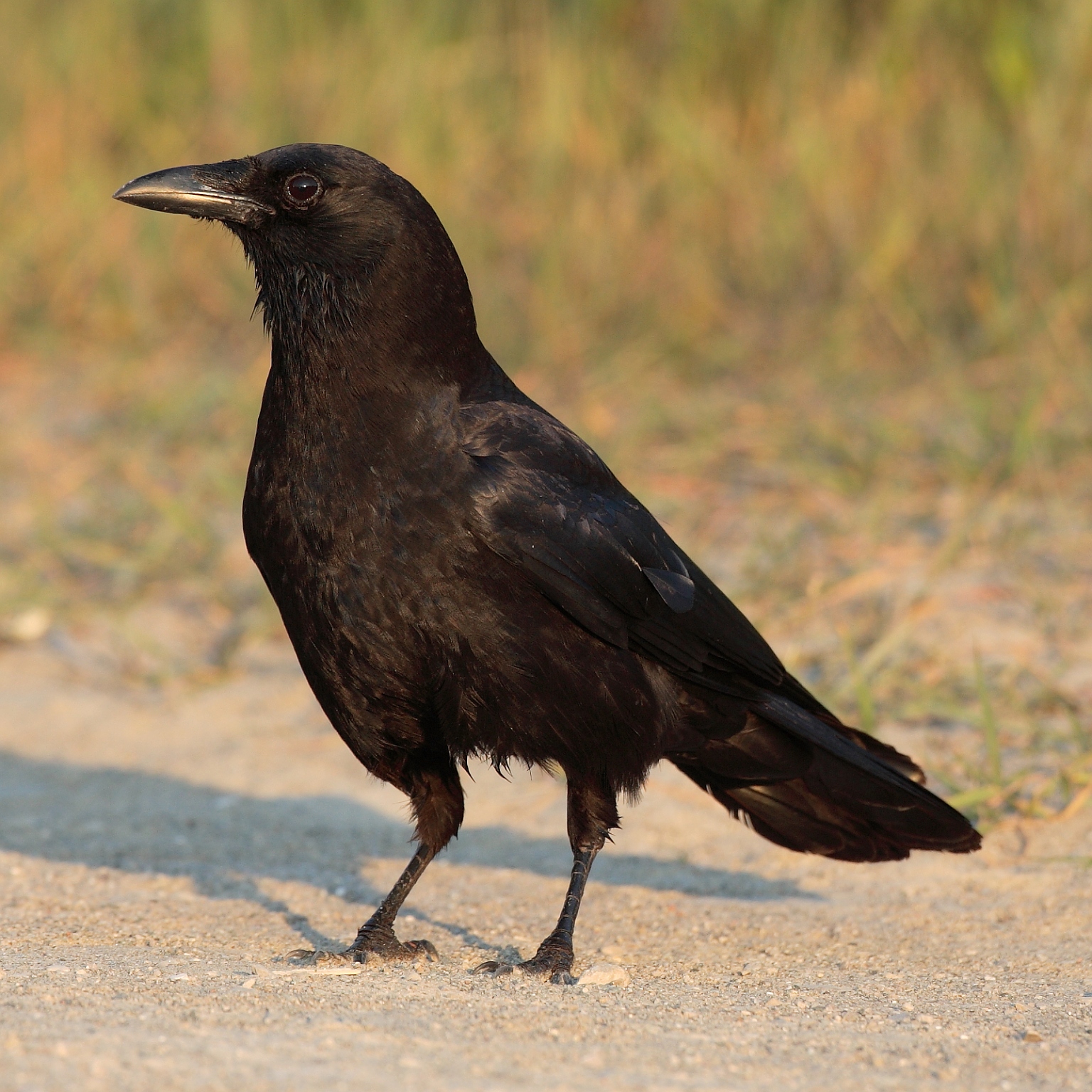 |
| The American Crow. A general predator to the California Least Tern. https://upload.wikimedia.org/wikipedia/commons/0/0a/Corvus-brachyrhynchos-001.jpg |
The California Least Terns have settled near Venice
Beach since at least 1894. There were emergency fencing placed around the
colony by beach managers in an effort to protect the nests. The fence has
somewhat allowed the colony to continue living peacefully with minimal
disturbance. [20] Since 1977, Venice Beach has “supported up to 16.6 percent of the
statewide pairs of breeding Least Terns and over 30 percent of statewide
fledglings.” [21] However, during
the last 10 years, the population has from a maximum of 12.4 percent in 1994 to
0.4 percent in 2004. Furthermore, the “proportion of fledglings produced at the
Venice Colony declined from 12.4 percent in 1994 to 6.9 percent in 2003, and
with no productivity in 2003, 2004, and 2005” [22] American Crows have played a large,
crucial part in this process.
 |
| Venice Beach Colony Productivity Chart http://i.imgur.com/B3D2haM.png |
Future of the Venice Beach ecosystem
Climate change is changing the conditions by which
the coastal and marsh ecosystem of Venice Beach is developing. Although
nature is rarely static, the changes now occurring in climatic conditions
across the coastal landscape are very fast in comparison to recent historical
rates, and may outpace the unassisted ability of many species and ecosystems to
adapt. [13]
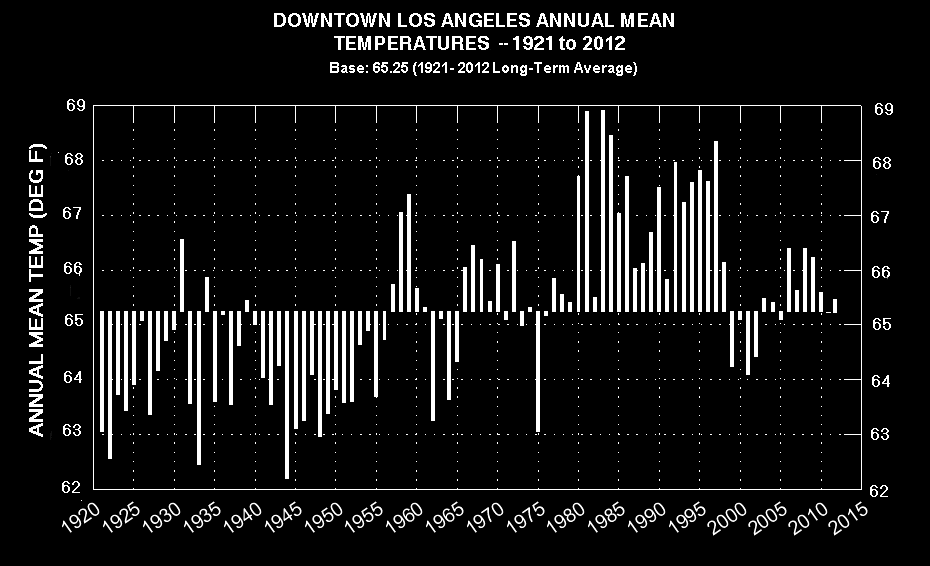 |
DOWNTOWN LOS ANGELES ANNUAL MEAN TEMPERATURE HISTORY (1921-2012)
|
At the worst case scenario, much of the area
surrounding Venice Beach will be inundated by seawater due to the rise in sea
levels. [10] It would thoroughly disrupt the already sensitive marshlands and
will increase opportunities will increase for non-native species invasions and
pest outbreaks.
 |
A Projection of the vulnerability of Los Angeles to Climate Change
|
What
should be done to preserve Venice Beach?
First, to tackle the problem of pollution in the Venice Beach area, The Heal the Bay Organization conducts monthly cleanups of beaches through it's volunteer "Nothin' but Sand" program. [23]
First, to tackle the problem of pollution in the Venice Beach area, The Heal the Bay Organization conducts monthly cleanups of beaches through it's volunteer "Nothin' but Sand" program. [23]
In order to improve human impacts on the coastal and
marshland ecosystem, policy makers should assign higher priority to the
protection, restoration, and management of those watersheds that provide the
greatest conservation benefits to aquatic ecosystems. [11]
 |
A split image of how Venice Beach would look like in the future if Climate Change isn’t mitigated.
|
Furthermore, policymakers should choose water
management actions that simultaneously meet societal needs while ensuring
resilient aquatic ecosystems. They could also suggest places where dikes should
be breached to restore tidal function, where transitions to new configurations
of tidal and freshwater marshes should be facilitated, or where engineering
solutions should be put in place to restore or maintain beaches and dunes by
enhanced sediment flows or retention. [12]
 |
A Possible future of Venice Beach
|
Sources
[1] King, Philip et al The Economic Costs of Sea-Level Rise to California Beach Communities
California Department of Boating and Waterways. San Francisco State University <http://www.dbw.ca.gov/PDF/Reports/CalifSeaLevelRise.pdf>
[2] Potter, Everett. America's most crowded beaches.
Web 18 July 2012 <http://travel.yahoo.com/ideas/america-s-most-crowded-beaches.html>
[3] US Army Corps of Engineers Hurricane and Storm Damage Reduction Project. US Army Corps of
Engineers Jacksonville District <http://bcs.dep.state.fl.us/env-prmt/sarasota/pending/0211217_Venice%20Erosion%20Control/005-JC/Application/Attach%20C%20Excerpt%20Draft%20LRR/Engineering.pdf>
[4] Rudd, Justin “Beach Trash & Debris."
30-Minute Beach Cleanup. Web. 13 July 2010. <http://www.beachcleanup.org/trash.html>
[5] "Beach Debris." Trecpi. Web. 14 July
2010.<http://www.trecpi.org/pdfs/BeachDebris%20pb2000.pdf>
[6] Goudie,
Andrew. The Human Impact on the Natural Environment. Great Brittian: MIT
Edition, 2000. Print.
[7] Lee, Kong et Al. Human Impact On Beaches Web 2010 <http://education.uncc.edu/cstem/sites/education.uncc.edu.cstem/files/media/SV/2010/QMRM/Kong%20Lee-%20Human%20Impact%20on%20Beaches.pdf>
[8] “Coastal Zone Recreation, Tourism and Beaches” Coastal Systems and Human Impacts <http://geology.campus.ad.csulb.edu/people/bperry/geology303/geol303chapter10.html>
[9] Alexander, Elayne et al. History of Venice Beach. 2 February 2009 Venice. Arcadia Publishing
[10] California Climate Action Team, Sea-Level Rise
Task Force of the Coastal and Ocean Working Group. 2010. State of California
Sea-Level Rise Interim Guidance Document.
[11] Feagin, R. A., N. Mukherjee, K. Shanker, A. H.
Baird, J. Cinner, A. M. Kerr, N. Koedam, A. Sridhar, R. Arthur, L. Jayatissa,
D. Lo Seen, M. Menon, S. Rodriguez, M. Shamsuddoha, and F. Dahdouh-Guebas.
2010. Shelter from the storm? Use and misuse of coastal vegetation bioshields
for managing natural disasters. Conservation Letters, 3: 1-11.
[12] Gedan, K. B., M.L. Kirwan, E. Wolinksi, E.B.
Barbier, and B. R. Silliman. 2011. The present and future role of coastal
wetland vegetation in protecting shorelines: Answering recent challenges to the
paradigm. Climatic Change 106: 7-29.
[13] National
Research Council. 2012. Sea-Level Rise for the Coasts of California, Oregon,
and Washington: Past, Present, and Future. National Academies Press,
Washington, D.C., 250 pp
[14] “LOS ANGELES
COUNTY BEACH HISTORY “ L.A. Beaches & Harbors
[15] Ryan, Thomas et al. Breeding Biology of the California Least Tern at Venice Beach, Marina Del Rey, California in the 2009 Breeding Season. State of California Department of Fish and Game Wildlife Branch <https://nrm.dfg.ca.gov/FileHandler.ashx?DocumentID=18214>
[16] California Coastal Commission. "Los Angeles County: Ocean Park and Venice." California Coastal Resource Guide. University of California Press, Jan 1, 1987, p. 294-295
[17] Goudie, Andrew. The Human Impact on the Natural Environment. Great Brittian: MIT Edition, 2000. Print.) (p.312)
[18] Carini, David. "Some Residents Upset Over Venice Beach Sand Dunes." Web. 12 December 2012 <http://venice.patch.com/groups/politics-and-elections/p/some-residents-upset-over-venice-beach-sand-dunes>
[19] Armendariz, Margarita et Al. Crow Density and Anthropogenic Subsidies Near the Venice, California Least Tern Colony. UCLA Institute of the Environment and Sustainability.
[20] Comrack, L. 2001. Venice Beach Least Tern colony enlargement and fence replacement. California Department of Fish and Game Report. November 29, 2001.
[21] Ryan, T. P., L. Seckel, and S. Vigallon. 2007. Breeding biology of the California Least Tern in Venice Beach, 2007 breeding season. Prepared for the California Department of Fish and Game, Office of Oil Spill Prevention and Response, SWCA Environmental Consultants. South Pasadena, CA.
[22] Ryan, Thomas et al. Venice Beach Least Tern Colony Habitat Improvement and Restoration Study, 2006-2009. State of California Department of Fish and Game Wildlife Branch <https://nrm.dfg.ca.gov/FileHandler.ashx?DocumentID=18218>
[23] Nothin' But Sand. Heal The Bay. 20 November 2013. <http://www.healthebay.org/get-involved/volunteer/cleanups#NothinButSand>
[16] California Coastal Commission. "Los Angeles County: Ocean Park and Venice." California Coastal Resource Guide. University of California Press, Jan 1, 1987, p. 294-295
[17] Goudie, Andrew. The Human Impact on the Natural Environment. Great Brittian: MIT Edition, 2000. Print.) (p.312)
[18] Carini, David. "Some Residents Upset Over Venice Beach Sand Dunes." Web. 12 December 2012 <http://venice.patch.com/groups/politics-and-elections/p/some-residents-upset-over-venice-beach-sand-dunes>
[19] Armendariz, Margarita et Al. Crow Density and Anthropogenic Subsidies Near the Venice, California Least Tern Colony. UCLA Institute of the Environment and Sustainability.
[20] Comrack, L. 2001. Venice Beach Least Tern colony enlargement and fence replacement. California Department of Fish and Game Report. November 29, 2001.
[21] Ryan, T. P., L. Seckel, and S. Vigallon. 2007. Breeding biology of the California Least Tern in Venice Beach, 2007 breeding season. Prepared for the California Department of Fish and Game, Office of Oil Spill Prevention and Response, SWCA Environmental Consultants. South Pasadena, CA.
[22] Ryan, Thomas et al. Venice Beach Least Tern Colony Habitat Improvement and Restoration Study, 2006-2009. State of California Department of Fish and Game Wildlife Branch <https://nrm.dfg.ca.gov/FileHandler.ashx?DocumentID=18218>
[23] Nothin' But Sand. Heal The Bay. 20 November 2013. <http://www.healthebay.org/get-involved/volunteer/cleanups#NothinButSand>
